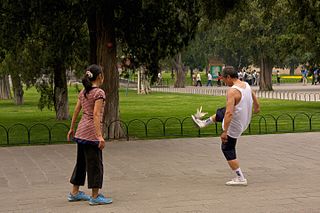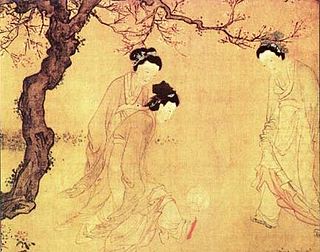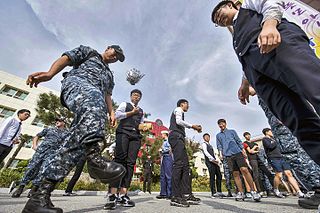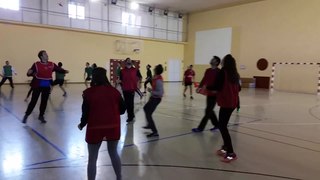
China has many traditional games, sports, and physical activities. [1]

China has many traditional games, sports, and physical activities. [1]
Chuiwan was an ancient Chinese game that can be considered an early form of golf. [2]
Cuju was an ancient Chinese game that is similar to association football. [3]
In jianzi, players attempt to keep a shuttlecock from falling to the ground by hitting it with any part of their bodies other than their hands. [4]
See also: Pitch-pot
In pitch-pot (also known as Touhu), players attempt to throw arrows in to a pot with a narrow mouth. The game is explained in the Book of Rites, one of the Five Confucian Classics. Pitch-pot traditionally was governed by many rules of etiquette, as explained in the Book of Rites, though nowadays the game has more informal versions.
In this game, one player is the eagle, another player is the chicken, and the remaining players are chicks. The chicks form a line behind the chicken by holding each other's waists, and the goal of the eagle is to tag the chicks, while the chicken tries to prevent this by holding their arms out and moving around. Throughout the game, the chicks must stay in the line formation, and if one of them is tagged, then they become the eagle. [5] [6]
All the players line up by holding each other's waists, with the player in the front known as the "dragon", and the player in the back known as the "tail". The goal of the dragon is to tag the tail, while all other players aim to prevent this by moving around. The players must stay in the line formation throughout the game, and once the dragon tags the tail, the players all move up one spot, with the former dragon now at the back of the line. [7] [8]
All but two of the players form a circle around a player called the "mouse", with one player known as the "cat" staying outside of the circle. The encircling players rotate around the mouse for a certain amount of time, and once they stop, the cat tries to tag the mouse while both players run in and out of the circle, though the cat has to follow the exact path taken by the mouse. [9] [7]
Go is a board game in which players attempt to surround their opponents' pieces on the board with their own pieces in order to "capture" the opponents' pieces. The player that captures the most overall territory on the board wins the game. [10]
Xiangqi is a board game with similarities to chess. [10] [11]
Pai gow is a gambling game played with dominoes, in which the goal is to get four tiles with numbers that add up to nine or more. [12] [10]
Dragon boat racing is over 2,000 years old, with either 10 or 20 participants trying to row the dragon boat as fast as possible. [13]
These games are played only by certain minority groups (ethnic or regional) in China.
Pearl ball is a Manchu game which is similar to basketball. Six players from each team compete on a 28x15m court, with the goal of the offense being to shoot the ball into a small net held by one of their teammates, while some of the defenders have paddles they can use to deflect the ball away from the net. [14] [15]

Badminton is a racquet sport played using racquets to hit a shuttlecock across a net. Although it may be played with larger teams, the most common forms of the game are "singles" and "doubles". Badminton is often played as a casual outdoor activity in a yard or on a beach; formal games are played on a rectangular indoor court. Points are scored by striking the shuttlecock with the racquet and landing it within the other team's half of the court.

A shuttlecock is a high-drag projectile used in the sport of badminton. It has an open conical shape formed by feathers or plastic embedded into a rounded cork base. The shuttlecock's shape makes it extremely aerodynamically stable. Regardless of initial orientation, it will turn to fly cork first, and remain in the cork-first orientation.

Tag is a playground game involving one or more players chasing other players in an attempt to "tag" and mark them out of play, typically by touching with a hand. There are many variations; most forms have no teams, scores, or equipment. Usually when a person is tagged, the tagger says, "It!" or "Tag, you're 'It'!" The last one tagged during tag is "It" for the next round. The game is known by other names in various parts of the world, including "running and catching" in India and "catch and cook" in the Middle East.

Jianzi, tī jianzi (踢毽子), tī jian (踢毽), or jianqiú (毽球), is a traditional Chinese sport in which players aim to keep a heavily weighted shuttlecock in the air using their bodies apart from the hands, unlike in similar games such as peteca and indiaca. The primary origin of jianzi is an ancient Chinese game called Cuju, from the Han dynasty, 2,000 years ago. Jianzi is played on a badminton court using inner or outer lines in different competition settings. It can also be played artistically, among a circle of players in a street or park, with the objective to keep the shuttle 'up' and show off skills. In Vietnam, it is known as đá cầu, and it is the national sport. In the Philippines, it is known as sipa and was also the national sport, until it was replaced by arnis in December 2009.

Football in China includes the practice of American football, arena football, association football, paper football, and other "football"-termed sports in the territory of the People's Republic of China that does not include Hong Kong and Macau.

Sipa is the Philippines' traditional native sport which predates the Spanish rule. The game is related to Sepak Takraw. Similar games include Footbag net, Footvolley, Bossaball and Jianzi.

Cuju or Ts'u-chü (蹴鞠) is an ancient Chinese ball game. FIFA cites Cuju as one of the earliest competitive ball games using the feet, but also that it did not influence any modern ball game. It is a competitive game that involves both teams trying to kick a ball through an opening into a central hoop without the use of hands whilst ensuring the ball does not touch the ground. This is similar to how hackey-sack is played today and the sport resembles a mix of basketball, soccer and volleyball. Descriptions of the game date back to the Han dynasty, with a Chinese military work from the 3rd–2nd century BC describing it as an exercise. It was also played in other Asian countries like Korea, Japan and Vietnam.

The ABU Asia-Pacific Robot Contest is an Asian-Oceanian college robot competition, founded in 2002 by Asia-Pacific Broadcasting Union. In the competition robots compete to complete a task within a set period of time. The contest aims to BUİLD friendship among young people with similar interests who will lead their countries in the 21st century, as well as help advance engineering and broadcasting technologies in the region. The event is broadcast in many countries through ABU member broadcasters.
The National Peasants' Games are a quadrennial multi-sport event in China in which competitors from among the country's 750 million rural residents take part in sports, both conventional - including basketball, athletics, table tennis, shooting, xiangqi and tai chi, and traditional rural and Chinese activities, such as wushu, dragon boat racing, lion dancing, tyre pushing, food-carrying, rice planting, kite flying, jianzi and tug of war. All of China's 31 provinces, autonomous regions and municipalities, as well as Taiwan, are represented. Hong Kong and Macau usually send observer delegations.

Jegichagi is a Korean traditional outdoor game in which players kick a paper jegi into the air and attempt to keep it aloft. A jegi is similar to a shuttlecock, and is made from paper wrapped around a small coin.

The history of games dates to the ancient human past. Games are an integral part of all cultures and are one of the oldest forms of human social interaction. Games are formalized expressions of play which allow people to go beyond immediate imagination and direct physical activity. Common features of games include uncertainty of outcome, agreed upon rules, competition, separate place and time, elements of fiction, elements of chance, prescribed goals and personal enjoyment.

Indiaca is a form of the Brazilian game peteca popular in Europe. It is played on court across a net with similar rules to volleyball but instead of a ball, a large shuttlecock, sometimes also called an indiaca, or featherball is used; this consists of four goose feathers attached to a heavier base, and it is controlled using the hands. In this way, indiaca differs from jiànzi, a very similar game originating in Vietnam and China, where the shuttlecock is controlled with the feet. Indiaca can be played by two individual players facing each other, or by small teams.
The All-China Games is a quadrennial national multi-sports event for non-Olympic sports in the People's Republic of China. The events are to "give priority to promoting national physical fitness and providing lots of fun for amateur athletes".

A footbag is a small, round bag usually filled with plastic pellets or sand, which is kicked into the air as part of a competitive game or as a display of dexterity. "Hacky Sack" is the name of a brand of footbag popular in the 1970s, which has since become a generic trademark.
Ginseng chicken soup is a type of soup, which involves chicken and ginseng as one of the main ingredients. Ginseng can typically be cooked with chicken in broth, porridge, and soups. Varieties of ginseng chicken soup can be found in Asian countries, such as China, Malaysia, and Korea.
Piao Taoyu is a Chinese footballer currently playing as a midfielder for Tianjin Jinmen Tiger.

India has several traditional games and sports, some of which have been played for thousands of years. Their popularity has greatly declined in the modern era, with Western sports having overtaken them during the British Raj, and the Indian government now making some efforts to revive them. Many of these games do not require much equipment or playing space. Some of them are only played in certain regions of India, or may be known by different names and played under different rules and regulations in different regions of the country. Many Indian games are also similar to other traditional South Asian games.
Myanmar has a number of traditional games, sports, and martial arts. Some of these games were designed to teach people how to protect themselves and their communities.
{{cite web}}: Missing or empty |title= (help)